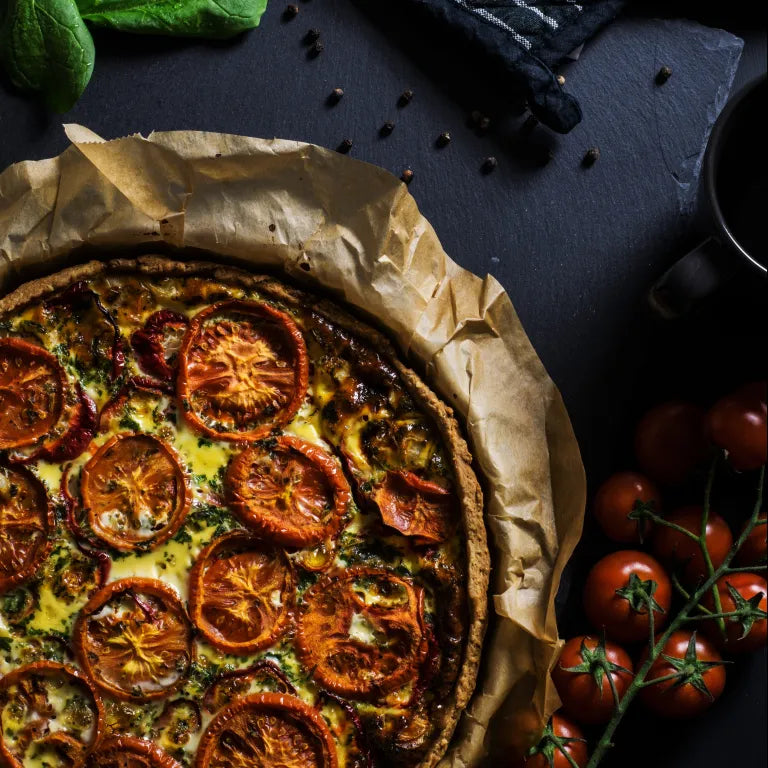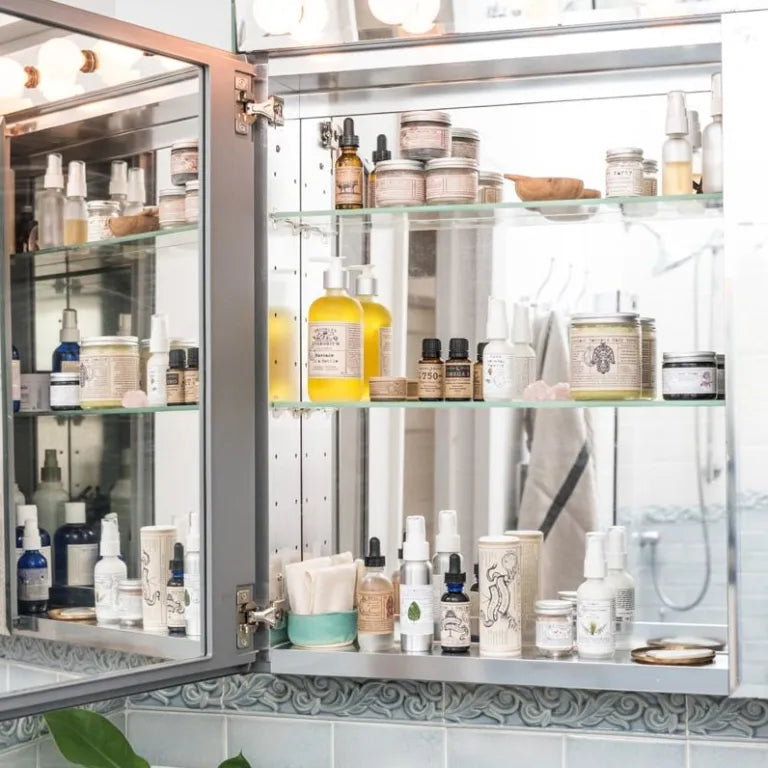Diet for Incredibly Good Skin Principles and Guidelines
Similar to the principles behind our Supportive Skincare Regimen, the point of offering dietary guidelines that lead to incredibly good skin is not that we think you should control the body by using specific foods, nutrients, herbs, or eating plans. Instead, our guidelines are meant to teach you how to give your body what it needs when it needs it and then get out of the way to allow the body to do the work.
When it comes to food, people with incredibly good skin tend to have three things in common:
- They time their meals to support metabolic flexibility, which is necessary if you want your body to make the right hormones at the right time (hormonal harmony).
- They balance the nutrients in their foods in a way that supports both digestion and elimination. This keeps the four pathways of detoxification (bowels, breath, urine, and skin) clear, providing a healthy terrain for the beneficial microbes of both the skin and the “skintestines” to flourish.
- They choose to enjoy traditional foods and food preparation over ultra-processed counterparts for most of their menus. Foods that are properly prepared are better digested, and the nutrients are more able to be assimilated into the body.
Seek Metabolic Flexibility
Metabolic flexibility describes the ability of the body to easily switch between using fat and glucose as fuel. When we taste something sweet, sour, or savory, the body produces insulin to deal with the coming glucose. When insulin is present, the body shifts into the “breakdown and store” mode that facilitates digestion. Once a meal has been digested and the insulin goes away, glucagon is able to become the dominant hormone. In a glucagon state, the body uses its stored fuel and nutrients to rebuild tissues, create non-digestive hormones, and perform clean-up measures.
The key to supporting metabolic flexibility without micro-managing your every bite, like the key to supporting your skin without getting on a control cycle with products, is to eat meals. Thats it. Three meals per day for most people. Four, if you are in a growth stage or need the extra energy. Perhaps two if you are more sedentary or later in life, or even one every once in a while for spiritual practice or to give your body a friendly challenge.
What you taste between your meals is also important. While “snacking” between meals is out (a planned 4th meal that you call a snack is OK), so is tasting anything that is sweet, sour, or savory between meals.
- No flavored water or fizzy drinks between meals. If you drink these, it should be with meals
- No bone broth between meals. Well, unless you are sick and using it as a medicine to replace meals because you feel so crappy. Otherwise, use your delicious broths as an ingredient in your soups, stews, and sauces.
- No herbal tea between meals. Not even our delicious teas, unless you are using it medicinally, and even then with meals is preferred.
- No gum. If you must have it, pop it in right after a meal.
- Coffee and black/green tea are ambiguous. If you put sugar or honey in your coffee or tea, nope–have it with a meal. Milk or milk substitutes will trigger insulin production as well. But black or with cream/half and half, some people can get away with. But not everyone. So unless you are sure it doesn’t set you off on a metabolic rollercoaster, you may want to consider consuming them with meals as well.
This leaves WATER. Hopefully, mineral water, or even just water with a pinch of salt mixed into it. Not water with lemon juice or vinegar. (You can have those directly before or with a meal)
So, as my Grandmother would say, “Eat when you are eating, and don’t eat when you are not eating.”
In addition, it is helpful to remember another thing you may have heard your elders(or was it Pink Floyd?) say…”How can you have any pudding if you don’t eat your meat???” In other words, treat sweet foods as desserts. Don’t let the first thing that you eat in any meal be sweet and don’t have sweet foods (or drinks!) by themselves. This includes fruit and honey. We love treats and sweets, however, when we taste that ultra-sweet taste that is fructose (found in fruit, honey, table sugar, and syrups) our bodies respond by producing a surge of insulin that can lead to a low blood sugar (hAnger, mood swings, and cravings) in the near future. If however, you have already eaten something that didn’t make insulin spike, eating these foods won’t send you on the same intense roller-coaster. So eat your meal first and save your sweets for after you have consumed a bit of something else.
Don’t Overload the Detox Systems
Each and every moment of each and every day, the body is processing “stuff” that it is taking in from the outside (even if it is just oxygen and sensory stimulus) and producing waste products that need to be released; otherwise, they will stay in your body causing all kinds of confusion. Though there are a few more alternate routes for waste to be eliminated, the four main pathways that we take into consideration are the bowels, the bladder, the lungs, and the skin. Yes, your skin is an essential organ of elimination, and if you have more waste than can be processed through those other organ systems, your skin will be overtaxed by having to take on more duties than nature intended.
If you already have metabolic flexibility, it is a boon because that means fewer hormonal ups and downs, resulting in fewer hormones being made and dumped throughout the day. We can also make the elimination function of the skin run smoother by reducing the amount of processing the body’s detoxification needs to do while at the same time increasing the productivity of the other three elimination pathways.
What this looks like in real-time is to keep the amount of super-intense compounds and confusing substances that your body has to deal with to an amount that is less than the amount of easily digested foods that your body uses for energy, processing nutrients, and eliminating wastes. Society has been pushing the idea that we need to replace macronutrients (Carbohydrate, fat, and protein) with micronutrients (vitamins, minerals, polyphenols, etc) as a way of reducing calorie consumption while still consuming a large volume of food, but this is not making anyone feel (or look!) any better over the long-haul.
This could also look like seasonal eating. Eating with the seasons does NOT mean eating and ample amount of imported brightly colored fruits and vegetables all year ‘round and more of certain specific ones when they are “in season.” It means that you will go through periods of time where there a foods you don’t eat because they are out of season. This is necessary only for your brightly-colored fruits and vegetables and “superfoods.” Humans have lived on dull foods that store well (grains, beans, potatoes, apples, cabbage) since the beginning of agriculture just fine.
Fat is also an important factor in a well-functioning body system. Humans don’t just use fat as good-feeling energy, we also need cholesterol (animal fat) to produce many of our hormones–particularly reproductive hormones, stress hormones, vitamin D (yes, it’s a hormone), and thyroid hormones. If we don’t eat cholesterol, our bodies will make it out of any type of macronutrient we give it: fat, carbohydrate, or protein. Dietary fat has never been the problem (except trans-fats, which is a type of industrial sludge that clogs up the working of the body and should have never been introduced as food) and the US no longer has an upper limit for the amount of fat a person should eat. High cholesterol has more to do with not getting enough soluble fibers in the diet for good elimination.
The soluble fiber in grains and beans is a necessary part of our detoxification pathways. If we aren’t getting any soluble fiber, the old cholesterol-dense-bile doesn’t have many opportunities to leave the body, so it gets reabsorbed into the bloodstream and recycled through the liver, making the new bile that is produced more and more toxic and more cholesterol stays in the bloodstream. Yet another case for a diet that includes both fat and carbohydrate for fuel.
People with incredibly good skin innately understand that we humans need macronutrients as our primary energy sources, with micronutrients in small doses. Trying to manipulate this balance with diet or supplements isn’t pretty, nor does it do your body–or your skin–any good.
Enjoy Your Food
When you are someone who enjoys food and enjoys eating, it is hard to live on the ultra-processed convenience products that line the supermarket shelves. There might be feelings of craving or excitement when you take the first bite, but rarely is the satisfaction in consuming foods that are designed to point your dopamine toward their shiny packages.
Traditional food preparation is not about eating foods that are “unprocessed.” We humans absolutely need to process our foods–especially plant foods, for us to digest them without trouble and assimilate their nutrients into our bodies. We aren’t goats who chew a cud or cows with four stomachs. We need to prepare these foods outside of our bodies before consuming them. The problem is most of the factory-produced items that you find in your typical grocery store don’t use traditional methods of preparation in their processing. Hence, they resort to adding supplements and fortification to try to replace what has been lost in their processing process. And that’s not good. That’s just more for your detox systems to deal with. Ughh.
The traditional process of preparing grains is to remove the chaff or the hull before consuming them. This idea of “whole grains” being “healthier” has only been around for a short time. Before that, for thousands of years, the wise women of every culture would spend huge amounts of their time and energy taking off as much of the outer portions as possible, making the grains more digestible. Our digestive systems have not changed in the past 100 years to make it possible for us to suddenly be able to handle breaking them down. This is why we recommend white rice and wheat, particularly the organic grains that have not had any enrichment or supplementation in them. Our favorite bread for everyday consumption is organic, white, and sourdough, although others can be substituted for variety.
Other traditional food preparations include cooking your vegetables (especially cruciferous ones–those that come from the cabbage plant) and using vinegar to break down the cell walls. Use vegetables as “pops” of excitement in your meals and delicious add-ins for your sauces, not as the main dish. Vegetables also make great digestion-helpers if you dress raw salads in oil and vinegar or use fermentation and/or vinegar pickling to pre-digest hard-to-digest veggies and serve as starters or condiments for your meals.
This is not to say that you have to prepare all of your foods from scratch. There are plenty of prepared foods that have been produced in factories using good ingredients and proper preparations. Many of these things are foods that we could even make in our own kitchens (if we had the equipment, time, knowledge, and desire), but some of them aren’t suitable for small-batch kitchen prep. At our Windsor Terrace location, we sell many of the prepared foods we buy and eat regularly including (but not always available) yogurt, cheeses, sauerkraut, kimchi, pickles, olives, pesto, pearled barely, tortillas, chips, popcorn, milled grains, bread, pasta, quick oats, cans of beans, dehydrated beans, hummus, beef jerky, salami, culinary oils, ghee, tinned fish, maple syrup, chocolate, sugar… We pay close attention to the quality and preparation of these goods.
You can look for these types of goods in any store once you know what you are looking for, although some areas will inevitably have more access than others, making you choose between lower quality or spending more time and money to get them or make them at home.
Sometimes we find ourselves in a situation where we don’t have a lot of control over what we are given to eat. Luckily, there is a fourth thing that people who tend to have incredibly good skin have in common: they aren’t stuck on the idea of perfection.
Dont Be Perfect
When you start where you are and do the best you can with what you have, it is so much easier to move in the direction of good health, well-being, and beautiful skin. When we aim to improve any part of our lives, direction is more important than speed. It doesn’t matter how fast you go if you are absolutely “perfect” and heading in a destructive direction. When you allow yourself to move slowly and take each imperfect moment as it comes, you are able to perpetually nudge yourself back into a direction that works with the body’s natural processes.
Having an imperfect diet can be helpful to your body in other ways, as well. In our “Sun Cycle, Moon Cycle, Earth Cycle” regimens, we talk about how small challenges can be beneficial to the skin’s resiliency so long as the skin consistently gets its needs met and the challenge doesn’t overwhelm it. The same is true for the body. When you are getting your basic needs met on a consistent basis (you are eating at mealtimes and resting at rest times, you are getting ample amounts of macronutrients and smaller amounts of micronutrients, and you choose traditionally prepared foods more often than not), going outside of these guidelines can be a boon for your system instead of a hindrance!
Get Help
Do you want incredibly good skin but are having a hard time making these guidelines work for you? Do you feel like you are doing all these things already, but your skin hasn’t gotten the message? Do you have special considerations or dietary restrictions that make it difficult for you to get your skin’s needs met? We can help you.
Brooklyn Herborium’s Holistic Practitioners are dual-educated as licensed estheticians and certified herbalists and have received extensive training and experience in using these principles to come up with individual selfcare plans to help you move from where you currently are to a place of beautiful, well-functioning skin without the use of harsh topical treatments, restrictive diets, or added stress to your life.
All of our Functional Facials (Level 1, Level 2, Level 3) include a consultation that can help determine what nudges need to be made to either your topical skincare or your personal selfcare. We can also accommodate Holistic Skincare Consultations and Functional Selfcare Consultations without a hands-on service, both in-person and virtually. You will be provided with educational handouts, including worksheets, checklists, and articles tailored to your needs so that you have something to reference when you need a refresher.



